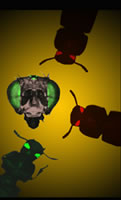Compound Eyes, Evolutionary Ties
October 2, 2006
By Kim McDonald

Photo Credit: Andrew Zelhof, UCSD
Biologists at the University of California, San Diego have discovered that the presence of a key protein in the compound eyes of the fruit fly (which glow at center due to a fluorescent protein) allows the formation of distinct light gathering units in each of its 800 unit eyes, an evolutionary change to an "open system" that enabled insects to make significant improvements in visual acuity and angular sensitivity. In contrast, beetles (shown surrounding the fruit fly), bees and many mosquito species have the light-gathering units fused together into a "closed system."
In a paper published in this week's early online edition of the journal Nature, the scientists report that one of three proteins needed to form these light gathering units is present in the visual system of fruit flies, house flies and other insects with open eye systems, but conspicuously absent in beetles, bees and other species with closed systems. The researchers showed that the loss of this protein, called "spacemaker," can convert the eyes of fruitflies-which normally have open eye systems-into a closed one. In contrast, the introduction of spacemaker into eyes with a closed system transformed them into an open one.
Charles Darwin was so enamored by the intricate complexity of the eye that he wondered how it could have evolved. "These results help illustrate the beauty and power of evolution and show how 'little steps'-like the presence of a single structural protein-can so spectacularly account for major changes in form and function," said Charles Zuker, a professor of biology and neurosciences at UCSD and a Howard Hughes Medical Institute investigator, who headed the research team.
Andrew Zelhof, a postdoctoral researcher working in Zuker's laboratory, was the first author of the study, which also involved Robert Hardy and Ann Becker of UCSD. The research was supported by the National Eye Institute of the National Institutes of Health and the Howard Hughes Medical Institute.
Media Contact: Kim McDonald, (858) 534-7572
Comment: Charles Zuker, (858) 534-5528
